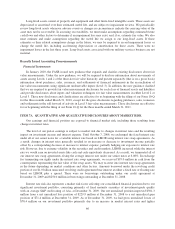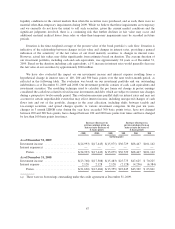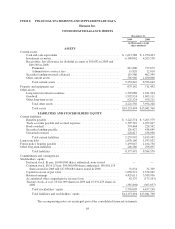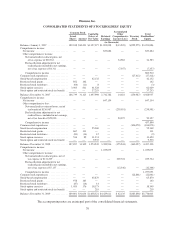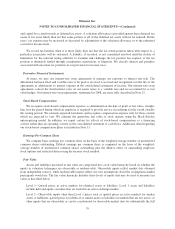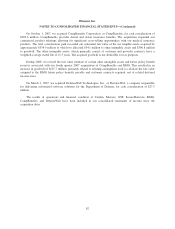Humana 2009 Annual Report Download - page 83
Download and view the complete annual report
Please find page 83 of the 2009 Humana annual report below. You can navigate through the pages in the report by either clicking on the pages listed below, or by using the keyword search tool below to find specific information within the annual report.Humana Inc.
NOTES TO CONSOLIDATED FINANCIAL STATEMENTS—(Continued)
Cash and Cash Equivalents
Cash and cash equivalents include cash, time deposits, money market funds, commercial paper, other money
market instruments, and certain U.S. Government securities with an original maturity of three months or less.
Carrying value approximates fair value due to the short-term maturity of the investments.
Investment Securities
Investment securities, which consist primarily of debt securities, have been categorized as available for sale
and, as a result, are stated at fair value. Investment securities available for current operations are classified as
current assets. Investment securities available for our long-term insurance product and professional liability
funding requirements, as well as restricted statutory deposits and venture capital investments, are classified as
long-term assets. For the purpose of determining gross realized gains and losses, which are included as a
component of investment income in the consolidated statements of income, the cost of investment securities sold
is based upon specific identification. Unrealized holding gains and losses, net of applicable deferred taxes, are
included as a component of stockholders’ equity and comprehensive income until realized from a sale or other
than temporary impairment, or OTTI.
In April 2009, the Financial Accounting Standards Board, or the FASB, issued new guidance to address
concerns about (1) measuring the fair value of financial instruments when the markets become inactive and
quoted prices may reflect distressed transactions and (2) recording impairment charges on investments in debt
securities. FASB also issued guidance to require disclosures of fair values of certain financial instruments in
interim financial statements to provide financial statement users with more timely information about the effects
of current market conditions on their financial instruments. The new guidance highlights and expands on the
factors that should be considered in estimating fair value when the volume and level of activity for a financial
asset or liability has significantly decreased and requires new disclosures relating to fair value measurement
inputs and valuation techniques (including changes in inputs and valuation techniques). In addition, new
guidance regarding recognition and presentation of other-than-temporary impairments changed (1) the trigger for
determining whether an other-than-temporary impairment exists and (2) the amount of an impairment charge to
be recorded in earnings. We adopted the provisions of the new guidance for the quarter ended June 30, 2009.
Refer to Note 4 and Note 5.
Under the new other-than-temporary impairment model for debt securities held, we recognize an
impairment loss in income in an amount equal to the full difference between the amortized cost basis and the fair
value when we have the intent to sell the debt security or it is more likely than not we will be required to sell the
debt security before recovery of our amortized cost basis. However, if we do not intend to sell the debt security,
we evaluate the expected cash flows to be received as compared to amortized cost and determine if a credit loss
has occurred. In the event of a credit loss, only the amount of the impairment associated with the credit loss is
recognized currently in income with the remainder of the loss recognized in other comprehensive income. A
transition adjustment to reclassify the non-credit portion of any previously recognized impairment from retained
earnings to accumulated other comprehensive income was required upon adoption if we did not intend to sell and
it was not more likely than not that we would be required to sell the security before recovery of its amortized cost
basis. We did not record a transition adjustment for securities previously considered other-than-temporarily
impaired because these securities were already sold or we had the intent to sell these securities.
When we do not intend to sell a security in an unrealized loss position, potential OTTI is considered using a
variety of factors, including the length of time and extent to which the fair value has been less than cost; adverse
conditions specifically related to the industry, geographic area or financial condition of the issuer or underlying
collateral of a security; payment structure of the security; changes in credit rating of the security by the rating
agencies; the volatility of the fair value changes; and changes in fair value of the security after the balance sheet
73





